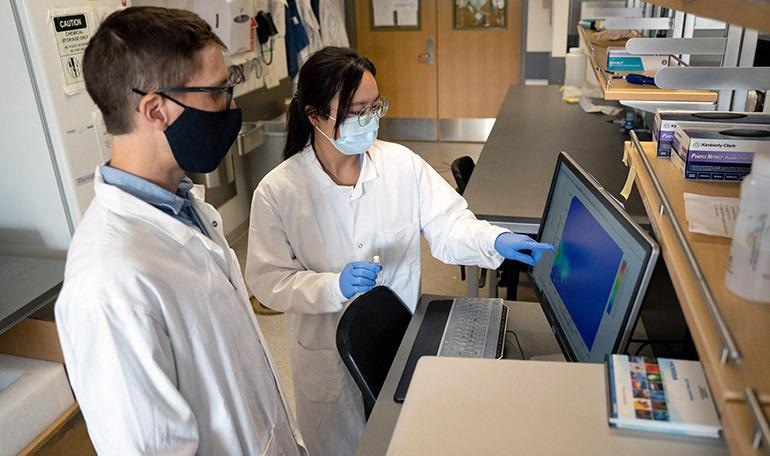Detecting pesticides and hydrocarbons in water in real-time could be achieved by shining a light beam into potentially contaminated water samples.
 UBC researchers Nicolas Peleato and Li Ziyu examine the data after testing a water sample with a fluorescence spectrometer. Image Credit: University of British Columbia.
UBC researchers Nicolas Peleato and Li Ziyu examine the data after testing a water sample with a fluorescence spectrometer. Image Credit: University of British Columbia.
Scientists from the University of British Columbia (UBC), Okanagan, have investigated the use of fluorescence to track the quality of water. The study findings presented by the researchers are promising.
Flashing a beam of light into the water excites the electron in molecules of some compounds and makes them emit light. The properties of the emitted light are similar to a fingerprint and can be utilized to determine some contaminants.
The challenge with using this fluorescence approach is that they are typically source-specific; meaning we have to calibrate for a particular water source and anticipate what specific contaminants we want to look for. In our latest work, we have developed a data processing technique that expands the effectiveness from one water source to others.
Nicolas Peleato, Assistant Professor, School of Engineering, University of British Columbia
This implies that the advancement eliminates a lot of assumptions at the start of the process. Peleato noted that every water source features a slightly different composition of organic compounds that are capable of hiding the contaminant signals, thereby making calibration for every source crucial to ensure detection accuracy.
Peleato and his graduate student Ziyu Li employed machine learning algorithms to engineer a method that eliminates the difficulties of source-specific models by mapping their similarities.
Li stated that this is not completely a one-size-fits-all method but somewhere close to it.
By establishing a process that identifies similar patterns between water sources, the fluorescence detection becomes a viable option for real-time, accurate detection of hydrocarbons and pesticides.
Ziyu Li, Graduate Student, University of British Columbia
The team analyzed unique shapes of fluorescence signals as part of the testing process. Every unique shape denotes the existence of impurities and helps scientists to identify the kind of impurity and differentiate it from other compounds.
It is a known fact that water contaminated with hydrocarbons is carcinogenic and can be harmful or poisonous to flora and fauna.
Currently, the focus of the scientists is to employ this new method for detecting and monitoring chemicals, like major toxic contaminants present in oil sand tailings ponds that might affect groundwater and surface water.
Building a comprehensive model that seamlessly transitions from one water source to another will speed up monitoring, and has the potential to be a game changer.
Nicolas Peleato, Assistant Professor, School of Engineering, University of British Columbia
The research was financially supported in part by the Natural Sciences and Engineering Research Council of Canada.
Journal Reference:
Li, Z & Peleato, N M (2021) Comparison of dimensionality reduction techniques for cross-source transfer of fluorescence contaminant detection models. Chemosphere. doi.org/10.1016/j.chemosphere.2021.130064.